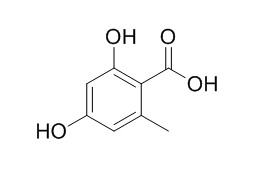Orsellinic acid
Orsellinic acid is a novel benzoquinone ring precursor for antroquinonol and 4-acetylantroquinonol B, it formed from acetyl-coenzyme Q (CoQ) and malonyl-CoA via polyketide pathway.
Orsellinic acid can block platelet activating factor (PAF)-mediated neuronal apoptosis without affecting G-protein coupled receptor (PAFR)-mediated neuroprotection, it can effectively attenuate PAFR-independent neuronal apoptosis.
Inquire / Order:
manager@chemfaces.com
Technical Inquiries:
service@chemfaces.com
Tel:
+86-27-84237783
Fax:
+86-27-84254680
Address:
1 Building, No. 83, CheCheng Rd., Wuhan Economic and Technological Development Zone, Wuhan, Hubei 430056, PRC
Providing storage is as stated on the product vial and the vial is kept tightly sealed, the product can be stored for up to
24 months(2-8C).
Wherever possible, you should prepare and use solutions on the same day. However, if you need to make up stock solutions in advance, we recommend that you store the solution as aliquots in tightly sealed vials at -20C. Generally, these will be useable for up to two weeks. Before use, and prior to opening the vial we recommend that you allow your product to equilibrate to room temperature for at least 1 hour.
Need more advice on solubility, usage and handling? Please email to: service@chemfaces.com
The packaging of the product may have turned upside down during transportation, resulting in the natural compounds adhering to the neck or cap of the vial. take the vial out of its packaging and gently shake to let the compounds fall to the bottom of the vial. for liquid products, centrifuge at 200-500 RPM to gather the liquid at the bottom of the vial. try to avoid loss or contamination during handling.
Food Funct.2022, 13(13):6923-6933.
Phytomedicine.2023, 120:155063.
Ind Crops Prod.2014, 62:173-178
Daru.2022, 30(2):273-288.
Evid Based Complement Alternat Med.2020, 2020:8582318.
Anal Bioanal Chem. 2016, 408(15)
RSC Adv.2024, 14(40):29319-29329.
Babol University of Medical Sciences2024, rs-4289336
Front Chem.2022, 10:1048467.
Phytomedicine.2018, 38:12-23
Related and Featured Products
J Nat Prod. 2005 May;68(5):724-8
Globosumones A-C, cytotoxic orsellinic acid esters from the Sonoran desert endophytic fungus Chaetomium globosum.[Pubmed:
15921417]
Three new esters of Orsellinic acid, globosumones A-C (1-3), and three known compounds, Orsellinic acid (4), orcinol, and trichodion (5), were isolated from Chaetomium globosum endophytic on Ephedrafasciculata (Mormon tea).
METHODS AND RESULTS:
The structures of the new compounds 1-3 were established spectroscopically, which included 2D NMR experiments and 1H NMR studies on Mosher's ester derivatives. All compounds were evaluated for inhibition of cell proliferation in a panel of four cancer cell lines, NCI-H460 (non-small cell lung cancer), MCF-7 (breast cancer), SF-268 (CNS glioma), and MIA Pa Ca-2 (pancreatic carcinoma), and normal human fibroblast cells (WI-38). Only globosumones A (1) and B (2) were found to be moderately active.
J Neurochem. 2007 Oct;103(1):88-97.
Platelet activating factor-induced neuronal apoptosis is initiated independently of its G-protein coupled PAF receptor and is inhibited by the benzoate orsellinic acid.[Pubmed:
17877634]
The bioactive lipid mediator platelet activating factor (PAF) is recognized as a key effecter of neuronal apoptosis, yet it is not clear whether its G-protein coupled receptor (PAFR) initiates or prevents PAF neurotoxicity.
METHODS AND RESULTS:
Using PAFR-/- and congenic wild-type mice, we show that PAF triggers caspase-3/7 activity and neuronal death in PAFR-/- but not PAFR+/+ cerebellar granule neurons. Restoring receptor expression by recombinant adenoviral infection protected cells from PAF challenge. Neuronal death was not mediated by nitric oxide or N-methyl-d-aspartate receptor signaling given that N-nitro-l-arginine methyl ester and MK-801 did not inhibit PAF-induced neuronal loss in PAFR-/- neurons. To intervene in PAFR-independent neurotoxicity, the anti-apoptotic actions of three structurally distinct PAF antagonists were compared to a panel of plant and fungal benzoic acid derivatives. We found that the PAF antagonist BN 52021 but not FR 49175 or CV 3988 inhibited PAFR-independent neurotoxicity. Orsellinic acid, a fungal-derived benzoic acid, blocked PAF-mediated neuronal apoptosis without affecting PAFR-mediated neuroprotection.
METHODS AND RESULTS:
These findings demonstrate that PAF can transduce apoptotic death in primary neurons independently of its G-protein coupled receptor, that PAFR activation is neuroprotective, and that Orsellinic acid effectively attenuates PAFR-independent neuronal apoptosis.
J. Agric. Food Chem., 2017, 65(1), 74-86.
Biosynthesis of antroquinonol and 4-acetylantroquinonol B via polyketide pathway using orsellinic acid as a ring precursor in Antrodia cinnamomea[Reference:
WebLink]
Antroquinonol (AQ) and 4-acetylantroquinonol B (4-AAQB), isolated from the mycelium of Antrodia cinnamomea, have a similar chemical backbone to coenzyme Q (CoQ).
METHODS AND RESULTS:
Based on the postulation that biosynthesis of both AQ and 4-AAQB in A. cinnamomea starts from the polyketide pathway, we cultivated this fungus in a culture medium containing [U-13C]oleic acid, and then we analyzed the crude extracts of the mycelium using UHPLC-MS. We found that AQ and 4-AAQB follow similar biosynthetic sequences as CoQ. Obvious [13C2] fragments on the ring backbone were detected in the mass spectrum for [13C2]AQ, [13C2]4-AAQB, and their [13C2] intermediates found in this study.
CONCLUSIONS:
The Orsellinic acid, formed from acetyl-CoA and malonyl-CoA via the polyketide pathway, was found to be a novel benzoquinone ring precursor for AQ and 4-AAQB. The identification of endogenously synthesized farnesylated intermediates allows us to postulate the routes of AQ and 4-AAQB biosynthesis in A. cinnamomea.



